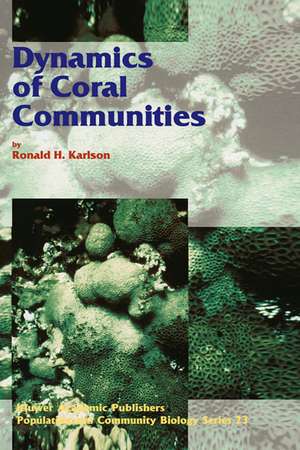Dynamics of Coral Communities: Population and Community Biology Series, cartea 23
Autor R.H. Karlsonen Limba Engleză Hardback – 31 aug 1999
| Toate formatele și edițiile | Preț | Express |
|---|---|---|
| Paperback (1) | 640.24 lei 6-8 săpt. | |
| SPRINGER NETHERLANDS – 31 oct 2002 | 640.24 lei 6-8 săpt. | |
| Hardback (1) | 644.95 lei 6-8 săpt. | |
| SPRINGER NETHERLANDS – 31 aug 1999 | 644.95 lei 6-8 săpt. |
Din seria Population and Community Biology Series
- 15%
 Preț: 646.11 lei
Preț: 646.11 lei - 18%
 Preț: 1224.54 lei
Preț: 1224.54 lei -
 Preț: 404.51 lei
Preț: 404.51 lei -
 Preț: 381.98 lei
Preț: 381.98 lei -
 Preț: 396.62 lei
Preț: 396.62 lei -
 Preț: 393.13 lei
Preț: 393.13 lei -
 Preț: 382.95 lei
Preț: 382.95 lei - 5%
 Preț: 373.47 lei
Preț: 373.47 lei - 18%
 Preț: 1221.38 lei
Preț: 1221.38 lei - 18%
 Preț: 1224.36 lei
Preț: 1224.36 lei -
 Preț: 383.71 lei
Preț: 383.71 lei - 24%
 Preț: 1045.08 lei
Preț: 1045.08 lei - 24%
 Preț: 1033.06 lei
Preț: 1033.06 lei - 18%
 Preț: 1228.62 lei
Preț: 1228.62 lei - 18%
 Preț: 1546.05 lei
Preț: 1546.05 lei - 18%
 Preț: 959.98 lei
Preț: 959.98 lei - 18%
 Preț: 953.65 lei
Preț: 953.65 lei - 15%
 Preț: 635.80 lei
Preț: 635.80 lei - 18%
 Preț: 950.52 lei
Preț: 950.52 lei - 18%
 Preț: 834.17 lei
Preț: 834.17 lei -
 Preț: 405.66 lei
Preț: 405.66 lei -
 Preț: 391.99 lei
Preț: 391.99 lei - 18%
 Preț: 1236.19 lei
Preț: 1236.19 lei - 15%
 Preț: 637.78 lei
Preț: 637.78 lei -
 Preț: 383.93 lei
Preț: 383.93 lei -
 Preț: 397.38 lei
Preț: 397.38 lei - 15%
 Preț: 640.06 lei
Preț: 640.06 lei
Preț: 644.95 lei
Preț vechi: 758.77 lei
-15% Nou
Puncte Express: 967
Preț estimativ în valută:
123.41€ • 128.60$ • 102.18£
123.41€ • 128.60$ • 102.18£
Carte tipărită la comandă
Livrare economică 03-17 aprilie
Preluare comenzi: 021 569.72.76
Specificații
ISBN-13: 9780412795503
ISBN-10: 0412795507
Pagini: 250
Ilustrații: X, 250 p.
Dimensiuni: 155 x 235 x 20 mm
Greutate: 0.54 kg
Ediția:1999
Editura: SPRINGER NETHERLANDS
Colecția Springer
Seria Population and Community Biology Series
Locul publicării:Dordrecht, Netherlands
ISBN-10: 0412795507
Pagini: 250
Ilustrații: X, 250 p.
Dimensiuni: 155 x 235 x 20 mm
Greutate: 0.54 kg
Ediția:1999
Editura: SPRINGER NETHERLANDS
Colecția Springer
Seria Population and Community Biology Series
Locul publicării:Dordrecht, Netherlands
Public țintă
ResearchCuprins
1 Introduction.- 1.1 Ecological communities, guilds, assemblages and webs.- 1.2 Taxonomic and trophic constraints.- 1.3 Scale-dependent dynamics.- 1.4 Marine epibenthic communities.- 1.5 Overview.- 2 Diversity.- 2.1 Origins of diversity.- 2.2 Patterns of coral diversity.- 2.3 Diversity of non-coral taxa.- 2.4 Overview.- 3 Stability.- 3.1 What is stability?.- 3.2 Are stability and diversity related?.- 3.3 Keystone species.- 3.4 Transient dynamics of nonequilibrial systems.- 3.5 Overview.- 4 Succession.- 4.1 Successional mechanisms on ecological time scales.- 4.2 Succession in coral communities.- 4.3 Overview.- 5 Interspecific competition.- 5.1 General considerations.- 5.2 Interspecific competition in coral communities.- 5.3 Overview.- 6 Consumer-resource interactions.- 6.1 Coupled populations, food webs, and interactive community processes.- 6.2 Food-web interactions of coral reef fishes: an example.- 6.3 Plant-herbivore interactions in coral communities.- 6.4 Predator-prey interactions in coral communities.- 6.5 Overview.- 7 Disturbance.- 7.1 Disturbance and species coexistence.- 7.2 Disturbances to coral communities: a potpourri.- 7.3 Do disturbances promote species coexistence?.- 7.4 Overview.- 8 Large-scale perspectives.- 8.1 General considerations.- 8.2 Evidence from coral communities.- 8.3 Middle ground.- 8.4 Overview.- 9 Integration across scales.- 9.1 The local environment.- 9.2 The regional setting and cross-scale linkage.- 9.3 A biogeographic context for coral community ecology.- 9.4 Closing comments.- References.
Recenzii
"The book provides a focus on the rich diversity and strong biological interactions that characterise the most fascinating coral communities. Defining community, guild, assemblage and web, the theme of the book is introduced with descriptions of the dynamics of coral community, especially of the constituent species, the interactions among them, the local environments, oceanographic transport processes, climatic fluctuations and a host of geographical and historical phenomena. The subject is narrated in thoughtfully and admirably organised chapters on diversity, stability, succession, competition and so on. Citing suitable examples, each chapter considers one or more selected principles, theories, hypotheses and models. In this process, new information is provided, for example that `coexistence competition' can be an alternative to competitive exclusion. Each chapter is closed with an overview, providing a sort of summary. The book includes useful references and subject index."
(Professor T.J. Pandian, Madurai Kamaraj University, India)
(Professor T.J. Pandian, Madurai Kamaraj University, India)











